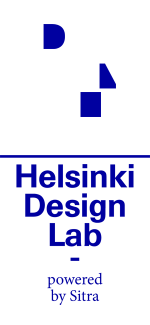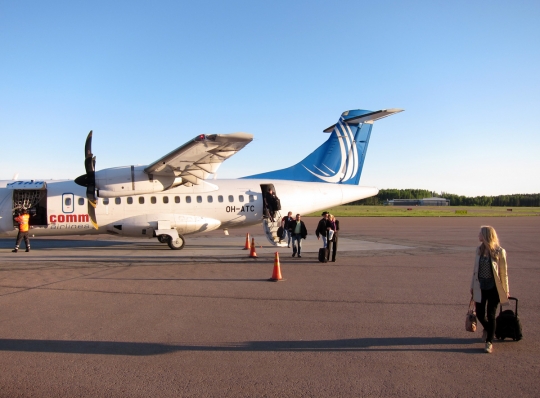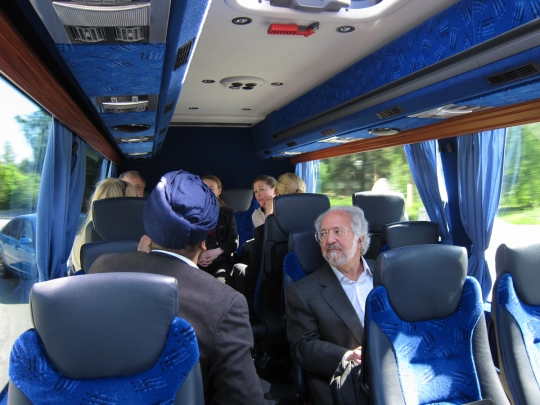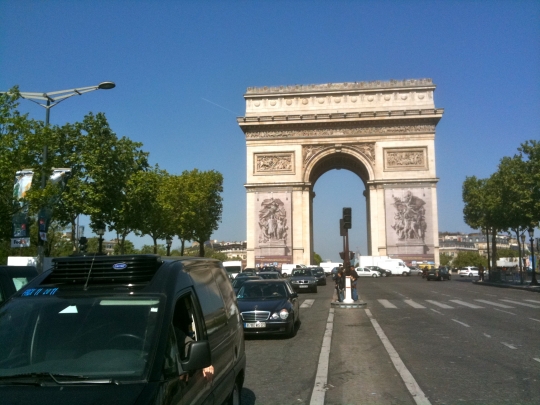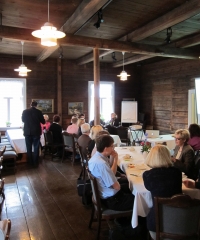Helsinki Design Lab helps government leaders see the "architecture of problems." We assist decision-makers to view challenges from a big-picture perspective, and provide guidance toward more complete solutions that consider all aspects of a problem. Our mission is to advance this way of working—we call it strategic design.
Yesterday was a whirlwind tour of Jyväskylä, which we visited to see a cross section of how one city thinks about its elders.
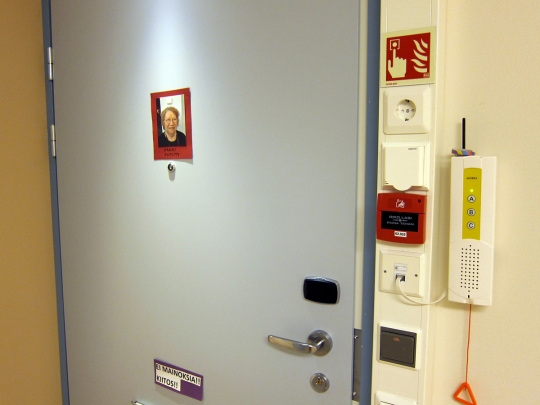
The balance between the human and infrastructural/institutional presence at an individual's front door inside an assisted living facility... interesting.
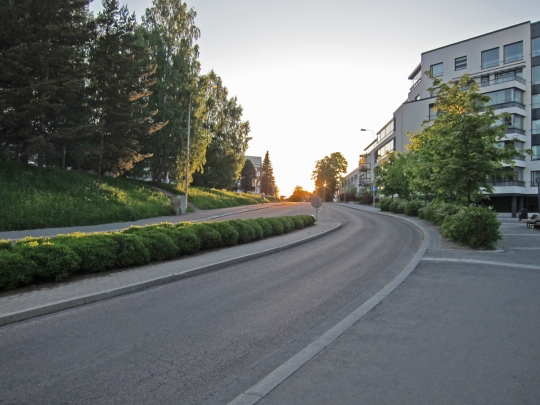
What it looks like at 11pm in the summer when you're at 62° north.
As Helsinki continues to warm up for the summer, we welcome a new group of guests who comprise our third HDL Studio, this time on ageing society. While the first two studios had relatively focused questions, this one is more open-ended. Around the world there's a lot of attention towards the coming "silver wave" of retiring Baby Boomers whose quantity, diversity of needs, and consumer orientation will put new demands on welfare systems. The challenge we face now, and the focus of this studio, is to develop an understanding of the relationships within this knotty issue—How do the pieces fit together?
Is ageing a health issue or a social issue? Is it a question of environments, isolation, mobility, independence? Is ageing just about the elderly? The nature of the challenge exists somewhere at the intersection of these many issues.
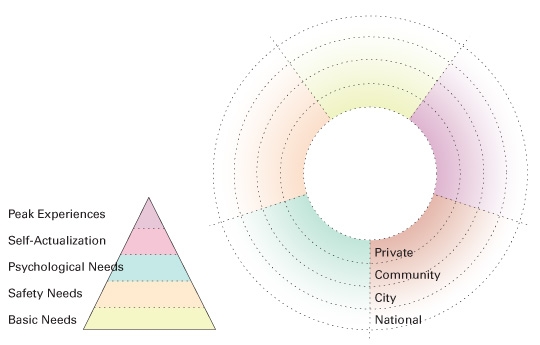
Maslow's hierarchy of needs expanded to a torus of actors.
Christina and Ankki, two Aalto University students who have been doing preparatory research in advance of the Ageing Studio's arrival, struck on an interesting way to map this web of needs and the groups responding to them. They started with Maslow's Hierarchy of needs in one dimension and the different scales of activity and support—from private, to city, to national—in another dimension. The key actors related to ageing are then slotted into this matrix. The result looks something like this draft:

The network of actors related to ageing in the city of Helsinki. In progress.
The visualization itself makes the gaps very apparent and the act of drawing becomes a process of discovery. More as this work develops.
And now, a hearty welcome to our HDL Studio on Ageing:
- Onny Eikhaug. Programme Leader, Design for All, Norwegian Design Council
- Dr. Marianne Guldbrandsen. Chief Designer, Design Council, London
- Alberto Holly. Professor Emeritus, University of Lausanne
- Inderpaul Johar. Co-founder, Zero-Zero Architecture Research, London
- Petri Lehto. Ministry of Employment and the Economy, Helsinki
- Dr. John Ruark. Adjunct Clinical Associate Professor of Psychiatry, Stanford University
- Hannele Seeck. Adjunct Professor, University of Helsinki
- Emily Thomas. Founding Director, Aequitas Consulting
If you want a peek into the life of the studio, follow #HDL2010 on Twitter where Inderpaul Johar is actively posting. Tomorrow we're heading to Jyväskylä for a full day of site visits as the studio continues to immerse themselves in the challenge.
When planning the HDL Studios we intended to have a two week gap between each. In the end, the schedule wiggled around a bit and we ended up with the HDL Studio on Sustainability and the HDL Studio on Ageing separated by only one week. Judging by the facial expressions I saw while looking around during our final prep meeting for the ageing studio, the difference in prep time is, in fact, no small difference. In honor of the hectic week, let's keep this short, sweet, and mostly photographic.
Taru and Kristiina began the wrap up work for the sustainability studio. This involves reviewing the tapes of the final presentation, transcribing all the stuff from the walls, and beginning to collate the two. Ultimately this will result in a document which summarizes the 'final review' of the studio and supports it with further information that was discussed early in the week but just couldn't fit into the final conversation.
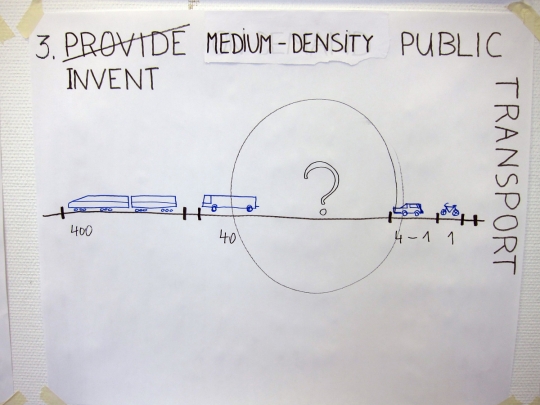
One of the paper "slides" from the sustainability studio, proposing one of ten action areas.
Alongside this work is a project to map the decision making territory around carbon. Who are all of the parties at the municipal, national, EU, and supranational level that have a decision making role affecting carbon? This is no small task and the research assistant teams have been fearlessly wading into the morass as they attempt to sort it out. When we started, I asked them to "draw the org chart of the problem," but now I see that this is more or less impossible: it's more of a disorg chart. These are huge messy tangles of relationships and it has been a very juicy challenge to sort it all out.
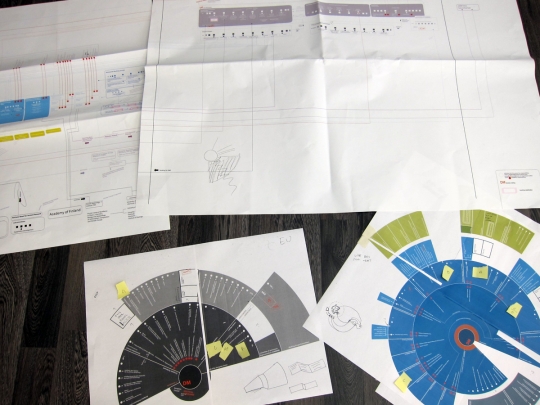
Working on a map of the decision making structure of climate change. The typical "org chart" style seen at the top has been abandoned for a radial arrangement in recognition that this situation is anything but organized.
Elsewhere in the studio, Christina and Ankki are at an earlier stage of a similar process, only their focus is on ageing rather than carbon. They started out with a pencil sketch, which is always a good idea.
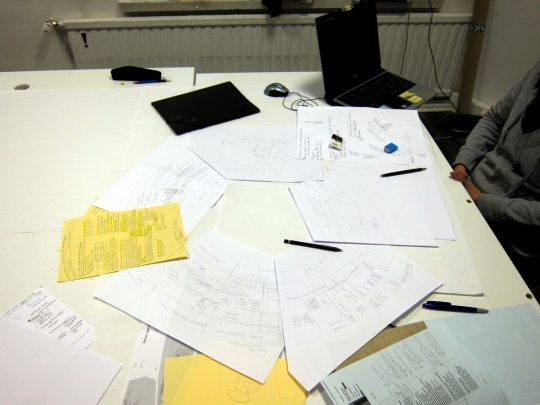
The decision making map for ageing in Helsinki is shaping up.
Just as the ageing studio is about to begin, the education studio is being fully wrapped up. Johanna and Rodrigo put in their last day of work as research assistants at HDL. Although their work on the education studio is over, we're still in the early stages of a larger arc of work to discover how the outcomes of the studio can be best applied. In fact, on Thursday we hosted some folks from the City of Helsinki to see if there's a possibility of collaborating on their work related to supporting immigrant students.
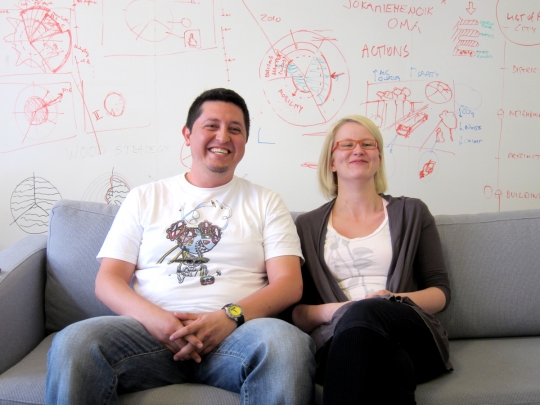
Rodrigo and Johanna completed their the education studio wrap up work today. It's been great to work with them, and we wish these two luck in whatever they pursue next.
This week Seungho also introduced us to a bit of his student work at Aalto University in a pair of posts (one, two) about Cambodia. He has promised to check in again with some of the outcomes of the semester, including a strategic framework to rethink the role of NGOs in that context.
So with that we will say goodbye to Week 065, as well as thank you to Johanna and Rodrigo.
This post continues the story of Seungho’s trip to Cambodia with Aalto University. Read the first part if you want to catch up...
So here we were, nine of us from five different countries seeing Cambodia for the first time. Seeing and living were very different from reading, watching and listening in comfortable homes and lecture halls. Things taken for granted at home were not easily achievable here: clean water, sanitation, sewage management, waste management and education, just to name a few.
We were lucky to have people with many different backgrounds: industrial and strategic design, architecture, urban planning and landscape architecture, which enabled each of us to focus on a few topics to develop deep insight so that we could help others see problems from various perspectives while working in teams. Nightly briefings kept everyone clued in and these discussions were very fertile. We were also lucky to have students from different parts of the world in the course, as well as working with Cambodian students during our stay, which made the whole visit fluent and fruitful. Soon we’ll return to Helsinki and form groups with those who did not travel, expanding the diverse set of perspectives even more.
We are free to choose a site for our studio projects. Among the most terrible of the relocation sites was Trapieng Krasang, where the urban poor from four different places were involuntarily relocated to some 20kms outside the city and they now struggle to survive. This is a population of Tuk-Tuk drivers, Moto-Dub drivers, bakers, street fruit vendors, waiters and waitresses who have been relocated away from their jobs and now have no income. One lady, for example, makes two and a half dollars a day if she goes to the city to sell vegetables. However, it costs two dollars to get to the city! The relocated families were each given nothing but a 5 by 12 meter plot on a former rice field. The earth is fertile there, but the plot is far too small to be the source of living, let alone the money to build a shelter.
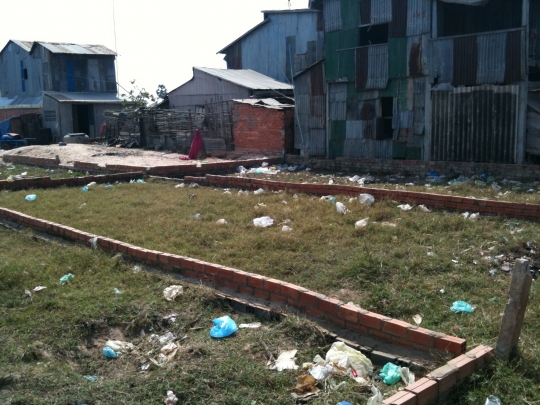
Empty plots in Trapieng Krasang. Many of the evicted families sold the plots for very cheap price and headed back to the city slums due to the lack of job opportunity. Sold plots have become the subject of speculation, which will make the rich richer.
This is compounded by the issue of unclear entitlements, which dates back to the Khmer Rouge regime when many citizens were herded out of the city. One third were killed and many of the survivors never returned. Eventually, those who did return to the city settled wherever they could – with whatever means they could. A few decades later, the Cambodian government, challenged with deep-rooted corruption, is selling the prime locations of Phnom Penh city to private investors who are taking advantage of murky land ownership status.
Development in the city of Phnom Penh is another significant problem. Two years back, a private investor bought the Boeung Kak Lake area which is about 1 square kilometer and began filling in the lake to build a hotel and resort. People near the lake have been forcibly relocated and a large fire during our stay in Phnom Penh cost hundreds of families their homes in a single night. Now Boeung Kak Lake is as small as one third and soon will be 10 per cent of its original size. As summer brings monsoon season we will see the impact of the such radical environmental changes. Recently the Royal University of Fine Art as well as the National Museum have been sold to a private investor and the students are under threat of eviction.
![Boeung Kak lake as of March 2010.
Photo credit: Save Boeung Kak Campaign [http://saveboeungkak.wordpress.com]](peoplepods/files/images/383.540.jpg)
Boeung Kak lake as of March 2010.
Photo credit: Save Boeung Kak Campaign [http://saveboeungkak.wordpress.com]
Some can say that development in Phnom Penh is giving jobs to construction workers, hopefully boosting the economy, and making the city a better place to live in the end. However, the number of the people evicted from the city is much higher than the number of workers hired. Does development have to be at the expense of so many homes, jobs, and lives lost?
The economy of urban poor in Phnom Penh is shallow and fragile: many of their livelihoods are very much dependent on tourism, a competitive industry with significant competition from nearby Bangkok. Cambodia imports many things, including foodstuffs, from Thailand and Vietnam, thus making commodities expensive. The shift from agrarian to industrial society, then an industrial, and on to a service and knowledge-based economy appears to be a long journey for Cambodia.
City in Crisis course does not pretend that problems of this nature can be mitigated immediately. Rather, it aims to have us students aware of and ready for the real problems of architecture and design for a longer term.
Back in Helsinki, we’re focusing on five different projects: a master plan including urban farming solutions for the relocation sites, in particular Trapieng Krasang as a case study; a “sub-center” concept for relocation sites, which brings markets and basic facilities to the area; the rehabilitation of remaining lake areas south of Phnom Penh, with specific attention to management of sewage flow; disaster management for slum inhabitants; and finally mine, a strategic road map and a framework for the economical development of the urban poor of Cambodia.
My question started from the living condition of Trapieng Krasang but my interest has soon extended to the economy of urban poor and the mindset: what does a pathway to economic stability look like for the relocated families of Trapieng Krasang?
I’m Seungho Lee, a Masters student at Aalto University School of Art and Design, studying in Industrial and Strategic Design and currently working with Helsinki Design Lab as an intern. My studies have taken me to Cambodia, where Aalto University's City in Crisis course is expanding the design discourse to include history, corruption, land entitlement, education, political enfranchisement, economics and more. This post was written a while ago, and it's part one of three covering my studies in the City in Crisis course.
As I type this, I’m 8000km away from home, waiting for a return flight from Phnom Penh, Cambodia back to Helsinki. I’ve been here for two weeks with nine of my fellow students as part of the City in Crisis course. Although I came to the airport three and a half hours early, I don’t mind because I wanted to escape from the city: there’s been a lot to digest after two quick weeks of fieldwork.
During that time we’ve been visiting Angkor Wat, the floating village near Siem Reap, Silk Island, a few slum areas and few eviction sites in Phnom Penh as well as relocation sites where those evicted now struggle to survive. We've also met and learned from representatives from various NGOs: STT, OPC, UN Habitat to name a few. Corruption, lack of secure tenure, almost no industry, false development, lack of education, slavery… this is the reality for many of Cambodia’s urban poor.
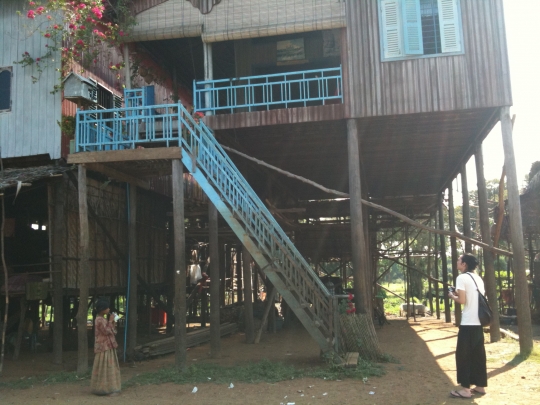
Floating village, a vernacular principle in Cambodia where the rainy season continues for six months.
Architects in the wealthy parts of the world have a tendency of being primarily interested in what their more successful counterparts in other wealthy parts of the world are busy with. The professional magazines in Europe, North America and the rich parts of Asia are concentrating on the “wow-factor” and its various manifestations. It is far less common that these publications deal with the everyday problems of the majority of the world’s problem.
– Hennu Kjisik, Veikko Vasko, & Hunphrey Kalanje. The Final Report of City in Crisis, May 2009
This phenomena is evident in recently published Phaidon Atlas of Contemporary Architecture that introduces 16 Finnish projects among 588 European projects, but only 26 projects from whole Africa and 184 projects from Asia. As pointed out by Hunphrey Kalanje, one of teachers of the course, architecture is in many cases political: it works with capital, for capital, and by capital.
The City in Crisis course has been offered since 1993 by the department of architecture in Aalto University School of Science and Technology with an aim of strengthening the global awareness and social conscience of its students, as well as increasing our understanding of the realities of life and conditions of professional work in developing countries.
Since these things are notoriously difficult to be taught in lecture halls and studios, the annual fieldwork period has become an essential part of the teaching and learning process since the beginning. After a total of ten years in Africa - Rusfisque, Benin and Grand Popo in particular - City in Crisis has turned its eyes to the east, and the first group of students traveled to Cambodia at the end of February 2008.
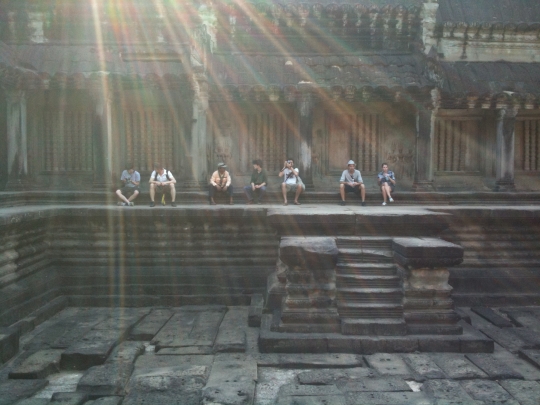
Some of my fellow students in the heart of Angkor Wat. One can easily imagine how glorious the Khmer civilization once had been.
The course is designed in two parts: the first of which aims to acquaint its students with various development issues all over the world and local vernacular principles. During the autumn semester in 2009, we read about and studied about four themes: development discourse, global issues, urban agendas, and construction in developing economies, which was followed by research into the vernacular principles of indigenous architecture in different climates.
The second part consists of lectures and seminars dedicated to issues in Cambodia, the fieldwork to Phnom Penh and Siem Reap and eventually the studio work back in Helsinki. From January of this year invited lecturers have talked about issues in relation with water, development, corruption, environmental issues, capital, and speculation in Phnom Penh.
After studying these issues from a range of scales, both from the global to the local in Cambodia, and from the past to the present we packed our bags for two weeks in Cambodia. It was time to see and to “live” the reality.
Check in tomorrow for more about our time in Cambodia.
During week 064 we tested the limits of the human brain by subjecting the eight members of the HDL Studio on Sustainability to an intense week of work. Like the Studio on Education before it, this was a rewarding week that left all of us energized to continue our work on these topics but desperately in need of a few days to decompress.
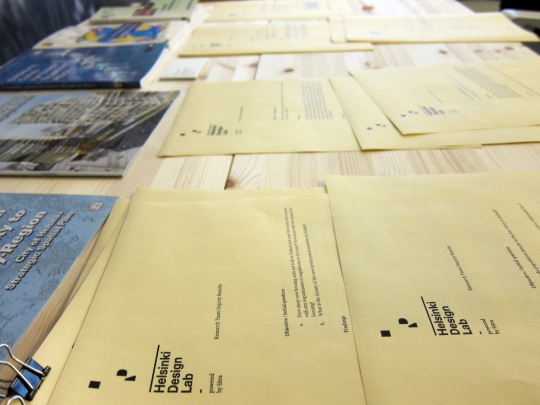
An array of research inquiry memos laid out on the "science lab table" in the studio. Supporting the studio members is a team of three research assistants who track down answers to questions and fix appointments. As the week wore on this table filled up.
For the final "review" we were joined by Mikko Kosonen, President of Sitra; Jukka Noponen, Director of Sitra's Energy program; Peter Lund, professor at Aalto and one of Finland's top experts in energy policy; Timo Mäkelä from the EC's Environment Directorate-General; and Helena Säteri, Director General of the Ministry of the Environment in Finland.
The conversation was wide-ranging but one major theme was the question of how to enable cross-ministerial action on sustainability, rather than just talk. As the studio heard from different stakeholders over the course of the week there are many cooperative relationships between the ministries and other key bodies, but these are generally non-binding. They have no teeth. The studio wondered if a "war on carbon" and a matching war cabinet be the right approach.
For now I'll leave you with that juicy tidbit and we'll check in later with the full outcomes, once the work has been transcribed and formatted in a sharable manner.
Wondering what the studio activities look like? Here's a video of five completely packed days compressed into 18 seconds. Looks easy, right?
While the Sustainability studio was ongoing, the HDL team was busy fixing last minute logistics for our next Studio on Ageing that begins in just six days, as well as continued effort on HDL Global 2010.
Justin had to duck out for a few days to attend a Low2No design meeting in London. While we were sad to have him gone in the middle of the Sustainability Studio, it's very exciting to watch Low2No begin to shape up.
What else?
Darrel Rhea wrote up his experience of the Studio on Education over at the Cheskin blog. We showed up in the Social Innovator methods index created as a collaboration between the excellent folks at NESTA and the Young Foundation. And did you know that you can follow HDL on twitter at @HDL2010?
It's already the wee hours of Monday, so technically this weeknote is being written on the first day of the HDL Studio on Sustainability. Tonight we welcomed the team to Helsinki with a quick dinner at Kuu Kuu before sending everyone back to the hotel to rest up in preparation for the quixotic week ahead.
Since we're at the very beginning of the week, let me introduce the studio:
- Alejandro Aravena. Executive Director, Elemental, Chile
- Dan Hill. Senior Consultant, Arup, Sydney (and prolific blogger)
- Janne Hukkinen. Professor of Environmental Policy, Helsinki University
- Seppo Junnila. Professor of Real Estate Business, Aalto School of Science & Technology
- Patricia McCarney. Director, Global City Indicators Facility, University of Toronto
- Federico Parolotto. Senior Partner, Mobility in Chain, Milan
- Matthias Rudolph. Project Leader, Transsolar, Stuttgart
- Katharina Schmidt. Masters of Spatial Design Student, Aalto School of Art & Design
This talented bunch will be spending the next five days with in Helsinki where their mission is to begin unpacking the complexities of carbon neutrality for Finland and to think about what a roadmap to carbon neutrality would look like.
One question we often get is "how do you pick the studio teams?" During the HDL Studio on Education someone went so far as to say that they felt like they were participating in an Agatha Christie novel: a group of people are mysteriously pulled together out of thin air—why are they here and what will they do now?
So, a few brief words describing our best guess as to how you build a successful team for this kind of work. To begin, it's important to know that as the research for the Challenge Briefings developed, we created expertise profiles for each studio. These were running lists that identified what we consider to be key perspectives for each studio topic.
In Sustainability we knew that building physics, transit, and policy would be essential areas, for instance. These are quite predictable. But we also sought some perspectives that might at first be unexpected. The thought behind this is simple: if you only include the regular suspects you will only get regular results.
Here are the basic rules of thumb that we used when thinking about the mix of the team and how to select the right individuals:
Keep it small: With too few people there's a danger that conversation will not be robust enough, but with too many people in the room it's difficult to have a single conversation. Based on experience, and a bit of advice from Dan Goldin, a team of eight is optimal. This has worked out very well for us. Some things work well in large groups, but strategy sessions are not one of them.
No room for duplicates: The studio team will be working quickly, which means that the collective expertise and experience in the room is the team's largest asset. Although team members may have some overlaps in their interests, it's best if each member is the master of their own domain and offers serious, focused expertise about their field. Each member becomes a 'representative' of their expertise and no one is redundant.
Only accept the best: When it comes to selecting individuals, we've gone straight to the top. Across the board, we feel that the studio members we've attracted are either at the top of their respective fields or upcoming talents. High quality input may not quite guarantee high quality output, but it's certainly a prerequisite.
Flexible expertise: It doesn't matter if you're the top expert on the planet in subject XYZ unless you're able to relate to others and convey your ideas in an open, productive manner. For this reason, we look for people who are at the top of their field, know their material inside and out, but are also naturally curious about the world around them, and able to sociably entertain models that conflict with their own.
Be (a bit) local: One of the great strengths of the HDL Studio format is that it offers a very fast and focused infusion of international expertise. But bringing in a wholly international group can lead to fruitless conversations when the cultural context is not understood. We set a rule of thumb for ourselves that two of the studio members would be Finns so there would always be 'cultural ambassadors' in the core team.
Design is the glue: Each of the studios have two designers who work as facilitators amongst a group of peer-experts. It's their job to ensure that the conversation is balanced and holistic. Only a particular kind of designer will work in this context. They need to be able to apply their training to strategic issues.
If these are the rules that guide our choices, one might ask how we first narrow the field. So far, the best indicator we have is that the kinds of people who succeed in collaborations with HDL are those who have significant experience in multiple cultures. Marco likes to use the term Third Culture Kid. This may be "culture" as it's typically defined or it may also refer to different cultures of expertise or work.
If I have the choice between an expert in astrophysics and an expert in astrophysics with a previous background in agriculture, my bet is on the latter. There's something about having lived in multiple cultures that prepares an individual for the kind of lateral thinking that is required in an HDL Studio.
Finally, the mix of the studio in terms of both expertise and personality is important. While one my be able to judge an individual's expertise by broswing a CV and reading some publications, it's very difficult to assess whether an individual will work well as part of a team unless you meet them in person. Sharing a phone call works too, but it's not as effective as having a face to face conversation with someone.
For all of these reasons listed above, we devote a lot of time to sketching out the right mix for a team, courting a qualified pool of invitees, and working to secure their participation. By way of example, the process of defining the HDL Studio teams began eight months before the first studio.
Editor's note: These reflections on developing the HDL Studio Teams have been updated in a new post here.
Which brings us to the end of this rather long weeknote. It was full of powerpoints: Marco spent Tuesday in Valamo, where he gave a presentation the Valamo Monastery's seminar on Divinity and Truth, and then closed the week as a respondent on a panel entitled "Helsinki – an Open and Cosmopolitan City?"
Meanwhile, I was in Paris to attend the SIX Spring School, to share our work at HDL, and to continue digging in to the ageing content in advance of our own Ageing studio which will happen in June. Thanks Geoff, Louise, and everyone else for a great event!
Hearing from each of the studio members as they made their way home last week, it sounds like it was an exhausting and exhilarating time for everyone. It has been more than a week since the HDL Studio on Education ended and personally I'm just now getting back to the normal routines of life.

Friday. A group discussion after the studio presented its findings and recommendations
Last time we checked in on the Education studio they were in the throes of developing a synthesized position on the education challenge. That work continued through the morning and afternoon on Friday and then we ended the day with a discussion between the studio, a number of people from Sitra, Timo Lankinen of the Finnish National Board of Education, and Maruja Gutierrez-Diaz of the European Commission. It was great to have such a high powered conversation in a group small enough that we could really dig into issues, a discussion that continued over dinner in the studio with the work of the week pinned up on the walls around us.
The question is: what next? One of the difficulties of the work of HDL and Sitra more broadly is that we're in the business of creating opportunities. Sometimes this means helping two organizations or individuals meet and discuss areas of possible collaboration; sometimes this means helping foster new business ventures, as Sitra's venture capital operation is well versed in; sometimes it means introducing new ideas into Finland, like the ways that Low2No has contributed to the discussion about sustainability; and sometimes it means creating space for reconsidering challenges from a new point of view.
So back to that question of what's next. From here we will continue the conversation with Timo and his colleagues, as well as our partners at the Ministry of Education, and other groups which are keen to learn more about the outcomes of the studio. In short, we're going to follow the opportunities as they arise—and we'll try to nudge a few along too.
Of course we have a couple ideas of what's next, but if we gave away all of our plans where would the fun be in that?
Besides feeling like a pack of exhausted zombies, this week was spent ramping up our next studio on sustainability while ramping down the studio on education. Ramping down involves transcribing the whiteboards, photographing everything, and reviewing the tapes of the final conversation. Ramping up involves continued work tracking down answers to questions that the studio members have sent in advance, so that they can hit the ground running.
And what else? It's spring, so we got some new flowers!
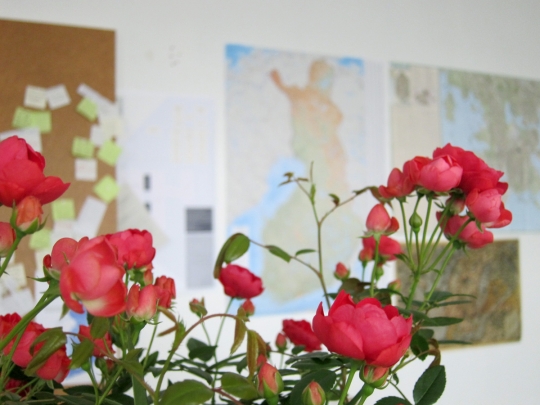
Actually, OK Do brought us the flowers. Thanks!
This summer HDL is hosting three separate studios here in Helsinki, each focusing on a topic that is critical to maintaining the wellbeing of Finland. Education, Sustainability, and Ageing are huge topics and there's no pretense that the studios will magically "solve" these issues. Rather, the goal of these studios is act as rocket fuel in the process of developing a strategic understanding of the issue. HDL Studios are part of a longer arc of work that began with the writing the Challenge Briefings last fall and will continue through this fall, if not longer.
HDL Studios are about making sure we ask the right questions. It's more about inspiration and insight than truth, as Rama Gheerawo eloquently put it.
Each studio is a group of eight people who've been assembled to represent key perspectives on the problem. For the education studio we have people with very deep experience in founding and running schools, extensive classroom teaching, as well as health, developmental psychology, learning, and media, and two designers with backgrounds in strategic work. Their task is to help the Ministry of Education think about its work in new ways, particularly with regards to Finland's dropouts.
In shaping the team HDL has been careful to look for people who have different points of view but are also able to suspend disbelief and engage other ways of thinking. It's probably also worth mentioning that for us the process of building the team was an intensely social one. Not only do the studio members have to be at the top of their field and able to collaborate well, but this specific group of people needs to gel socially. From the intensity of the work over the past couple days it seems like this is exactly what has happened.
Without further ado, the HDL Studio on Education:
- Dr. Jane Holmes Bernstein. Senior Associate in Psychology/Neuropsychology, Children's Hospital Boston
- Maja Kecman. Senior Associate, Helen Hamlyn Centre, Royal College of Art
- Lai Cheng Lim, Principal of the Raffles Institution, Singapore
- Ann McCormick. CEO, Learning Friends Inc. in California's Bay Area
- Roope Mokka. Development Director of Demos Helsinki
- Linda Nathan. Founding Headmaster of Boston Arts Academy
- Darrel Rhea. CEO of Cheskin Added Value in California's Bay Area
- Dr. Juha Teperi. Programme Director, Ministry of Social Affairs and Health
The team is here in Helsinki for just one week. In this incredibly limited window of opportunity we've pre-arranged a schedule for them that is front-loaded with opportunities to hear from local stakeholders before transitioning into synthesis mode, which is where they're at right now as Thursday winds down.
Monday was focused on macro-level issues here in Finland. From the socioeconomic development of the country to the realities of multiculturalism in schools, it was an intense and diverse brain dump of information. The next day we visited a school in Helsinki to see what education looks like on the ground. Wednesday and Thursday were intense days of discussion and now everyone is working in smaller groups to bring the salient thoughts into focus. Tomorrow afternoon the studio will share their thoughts with guests from Helsinki and Brussels and then we'll continue that discussion over dinner.
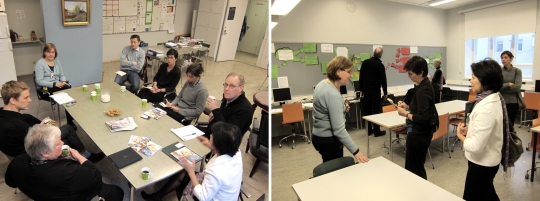
Principal Erja Hoven taking the studio on a tour of Ressu, one of Helsinki's comprehensive schools
Meals are not to be underestimated in a process like this. Since the team has precious little time together, meals are very important opportunities to change the tenor of the conversation and let ideas percolate in a different way. At one point on Tuesday I counted seventeen cups and beverage containers on the table with eight chairs around it—a messy table is a productive table.
More soon.
We continued the sprint to wrap up the final details of preparing the studio space for our first guests. This involved lots of tiny things like getting the our name on the sign downstairs and finding a good water pitcher. Seungho took care of these with aplomb.
Meanwhile, Rodrigo and Johanna have been wading through piles of official documents and lots of phone calls to continue their work drawing out the organizational chart of the education system. This sort of work very easily turns into spaghetti, so we've been taking it slow. Part of the ramp up phase for the studio assistants is a nice dinner to get to know everyone. Annikki and I had the pleasure of taking the Sustainability Studio and the Ageing Studio to dinner this week which means that all three teams have officially booted up.
Marco, Hanna, Annikki, and I spent Thursday in Jyväskylä, where Sitra sponsored a workshop with a wide cross section of stakeholders who deal with issues relating to the elderly in that city. We heard a bit about some of the challenges of delivering care to a broad variety of different groups of people. One of the key issues in Jyväskylä, as well as the rest of Finland, is that it includes a dense urban core as well as vast expanses of lightly populated rural areas. Delivering equal levels of care to people in such disperate physical environments becomes a tricky proposition. This was preliminary work for the Ageing Studio which happens in early June.
And tonight things suddenly became very real. Marco and I met the Education Studio members who've just flown in from Singapore, London, San Francisco, Boston, as well as the two locals from Helsinki, and took them out to a neighborhood dinner in Töölö. Shaking the hands of these excellent people who've come to spend a week with us really underscored the fact that, oh yeah, this thing we've been planning for over a year begins tomorrow!
